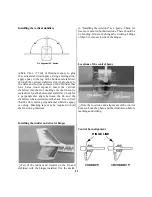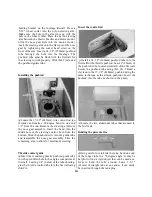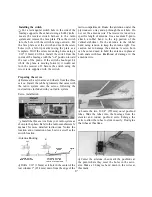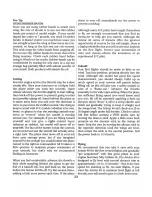
Control Surface Throws
We recommend the following throws:
NOTE: Control throw (movement) is measured
at the trailing edge of the elevator, rudder and
ailerons. Hold a ruler vertically on your
workbench or block it up on books to make
these measurements.
ELEVATOR: 3/8" up
3/8" down
RUDDER: 3/4" right 3/4" left
AILERONS: 5/16" up 5/16" down
NOTE: The balance and control throws for the
Avistar 40 have been thoroughly tested and
represent the settings at which the Avistar 40
flies best. Please set up your Avistar 40 to the
specifications listed. If, after a few flights, you
would like to adjust the throws to suit your
taste, that's fine. Remember, "more is not better."
Note: If your radio system does not feature
Adjustable Travel Volume (ATV's), you will have to
mechanically adjust control surface throw.
Q Control throw adjustment: If you move the clevis
at the control horn on the control surface toward
the outermost hole, you will decrease the amount
of throw. If you move the clevis to a hole nearer the
control surface you will increase the amount of
throw. If these adjustments do not provide the
desired throws, you may need to work with a
combination of adjustments by repositioning the
pushrod at the servo. If you move the pushrod
toward the splined shaft on the servo arm, it will
decrease the control surface throw - outward will
increase it.
Ground Stance
NOSE
TOO HIGH
NOSE
TOO LOW
LEVEL
Q "Eyeball" the side of the fuselage from 6 - 10 feet
away. If necessary adjust the height of the nose by
raising or lowering the nose gear wire so that your
model will sit pretty much level, as shown in
the sketches.
Once the correct ground stance is established,
tighten the screws on both the steering arm and
wheel collar on the flat spot of the nose gear wire to
lock the nose gear strut in position. Use thread lock
on both screws.
It is a good practice to periodically check the ground
stance of your Avistar 40 - especially after a hard
landing. The wire landing gear is designed to absorb
shock from rough landings but occasionally may
need to be bent back into position.
Charge the Batteries
Follow the battery charging procedures in your
radio instruction manual. You should always
charge your transmitter and receiver batteries the
night before you go flying and at other times as
recommended by the radio manufacturer.
Balance the Propeller
Balance your propellers carefully before flying. An
unbalanced prop is the single most significant
cause of vibration. Not only will engine mounting
screws and bolts vibrate out, possibly with
disastrous effect, but vibration will also damage
your radio receiver and battery. Vibration will
cause your fuel to foam, which will, in turn, cause
your engine to run lean or quit.
We use a Top Flite' Precision Magnetic Prop
Balancer'" (#TOPQ5700) in the workshop and keep
a Great Planes Fingertip Balancer" (#GPMQ5000)
in our flight box.
20





































